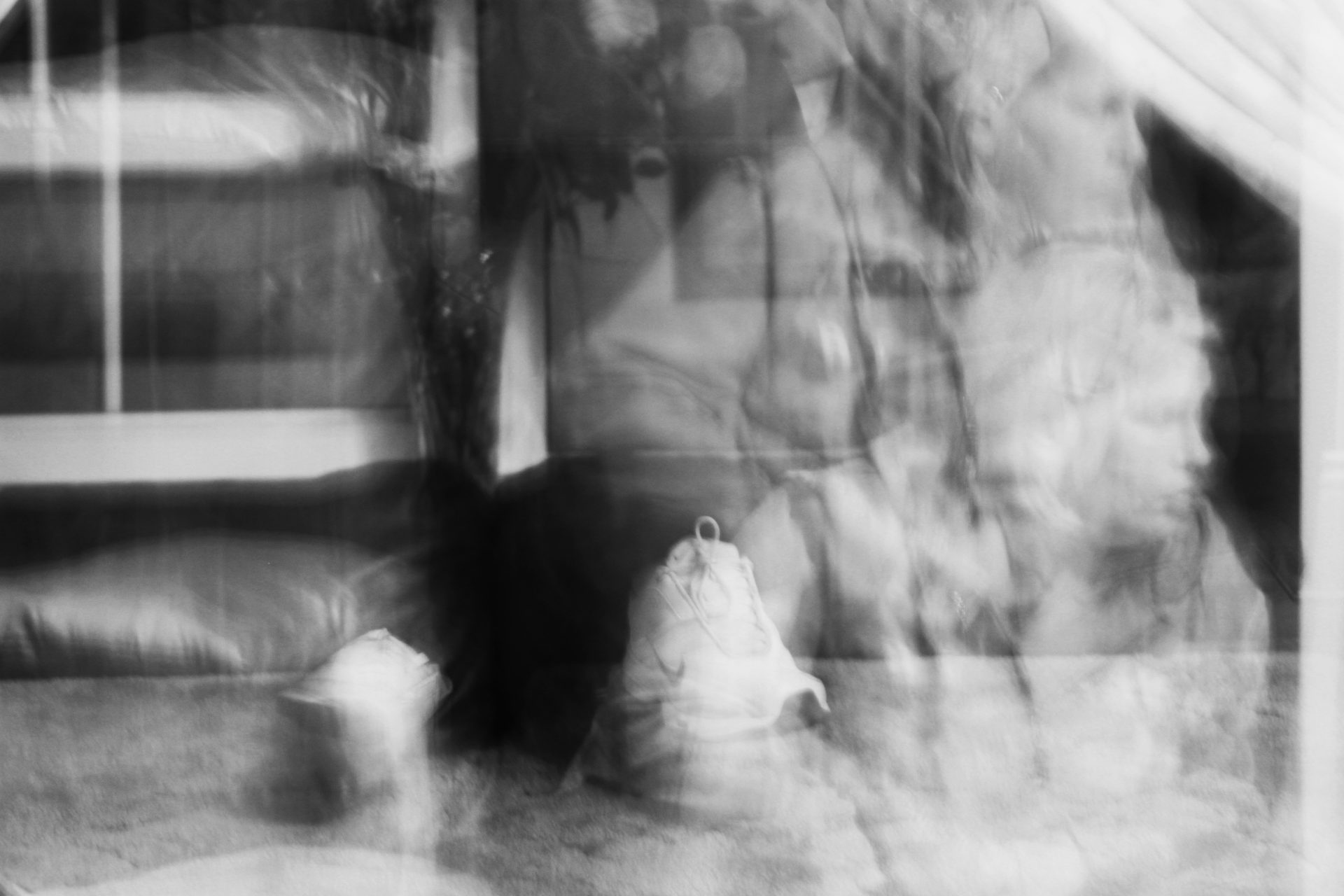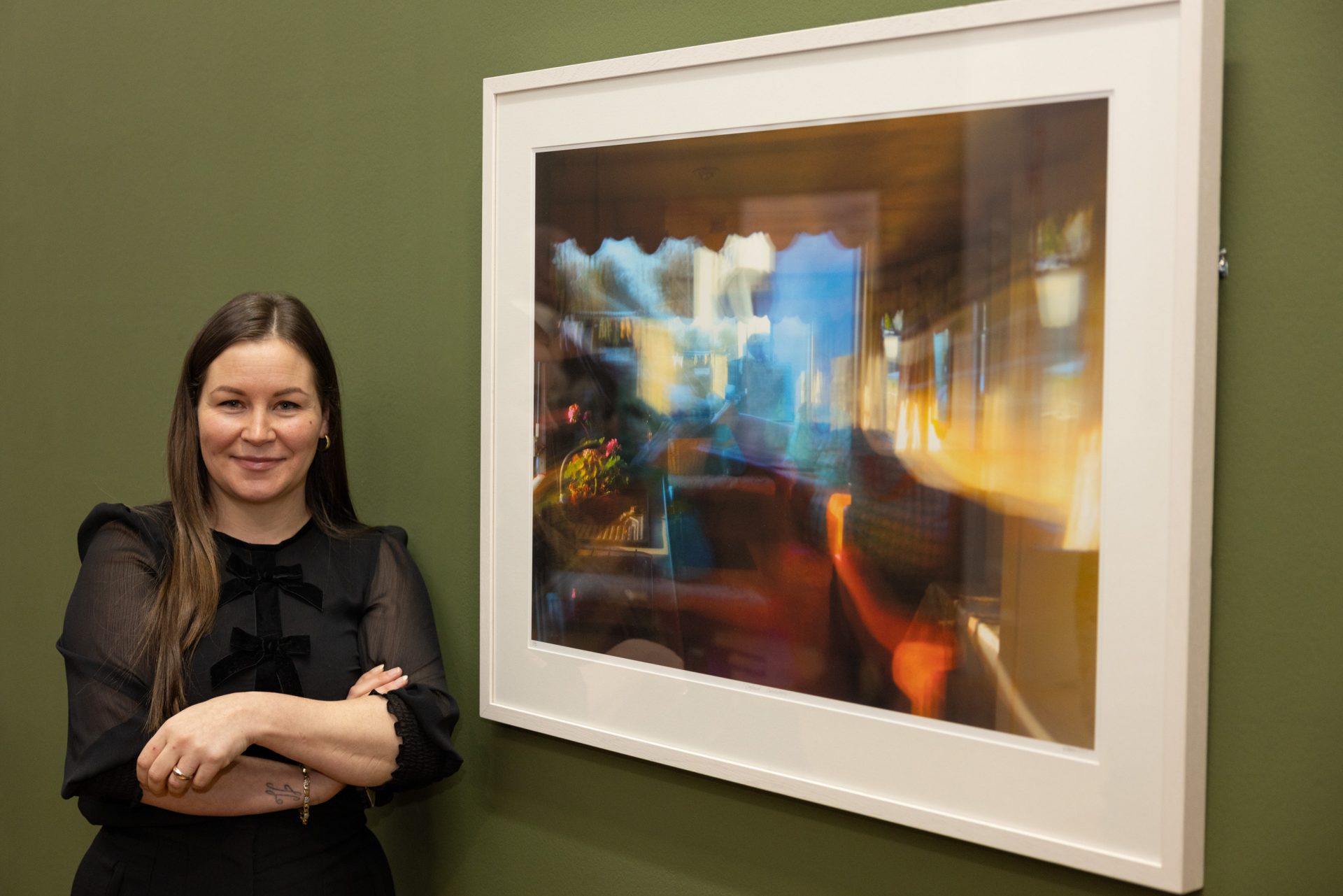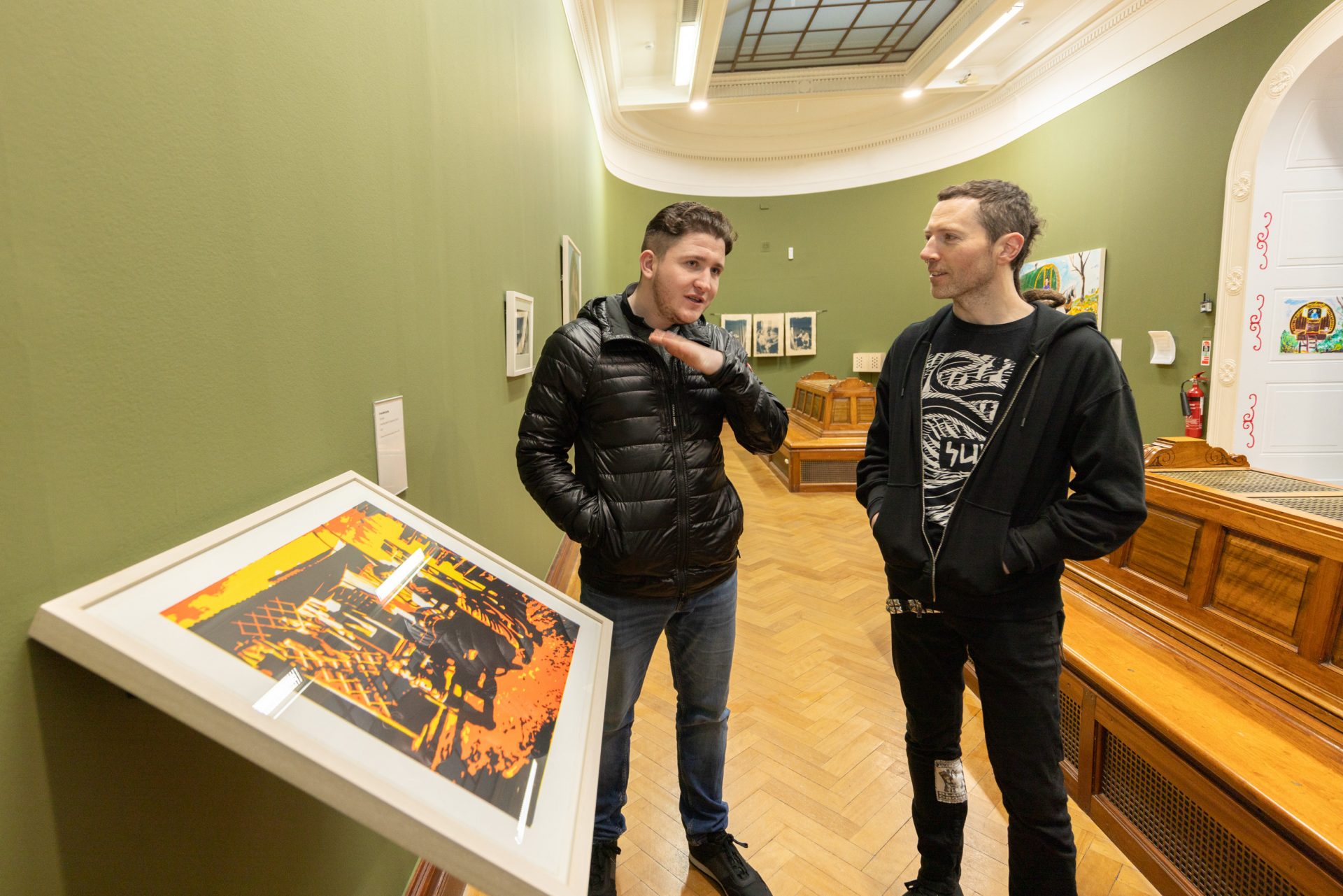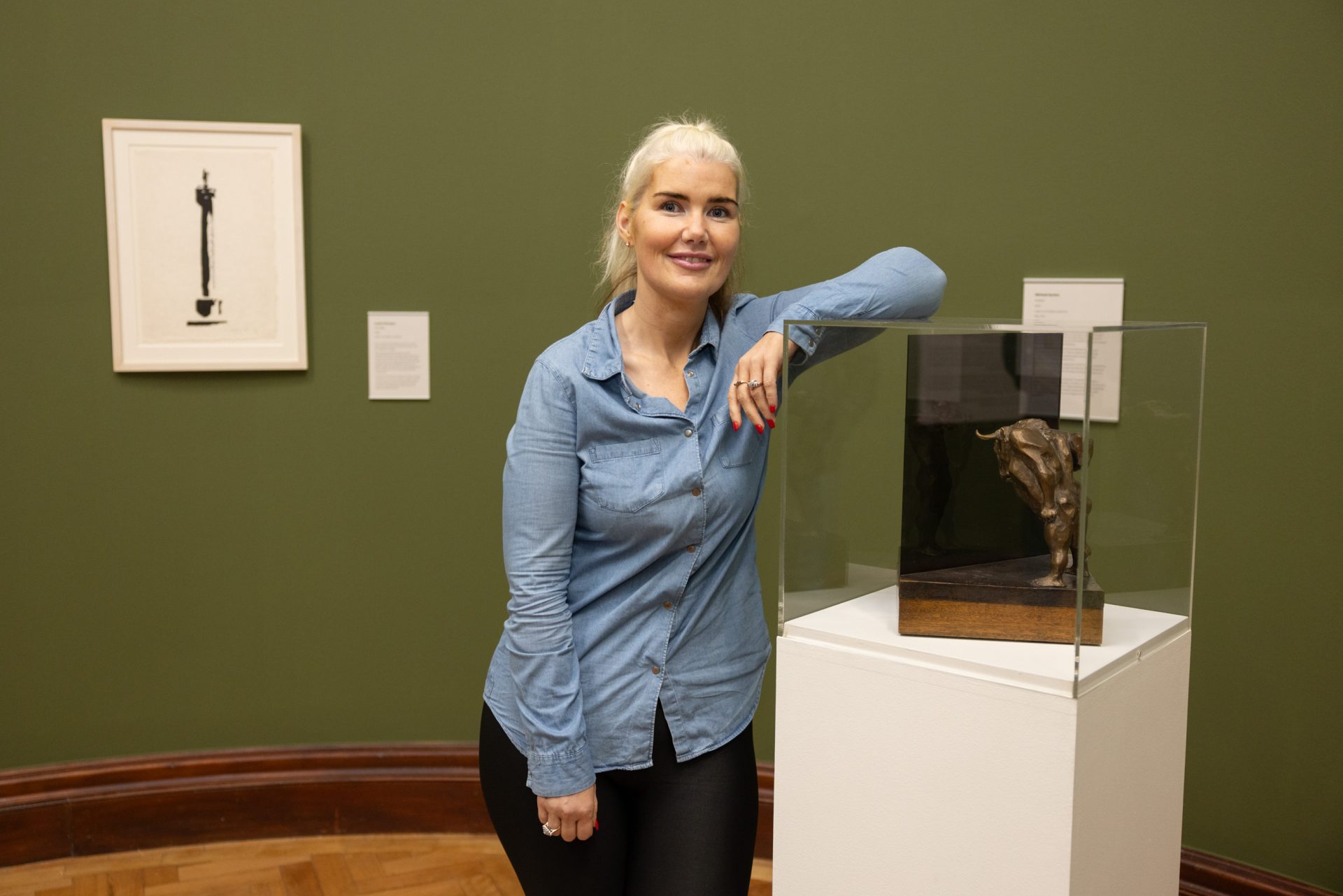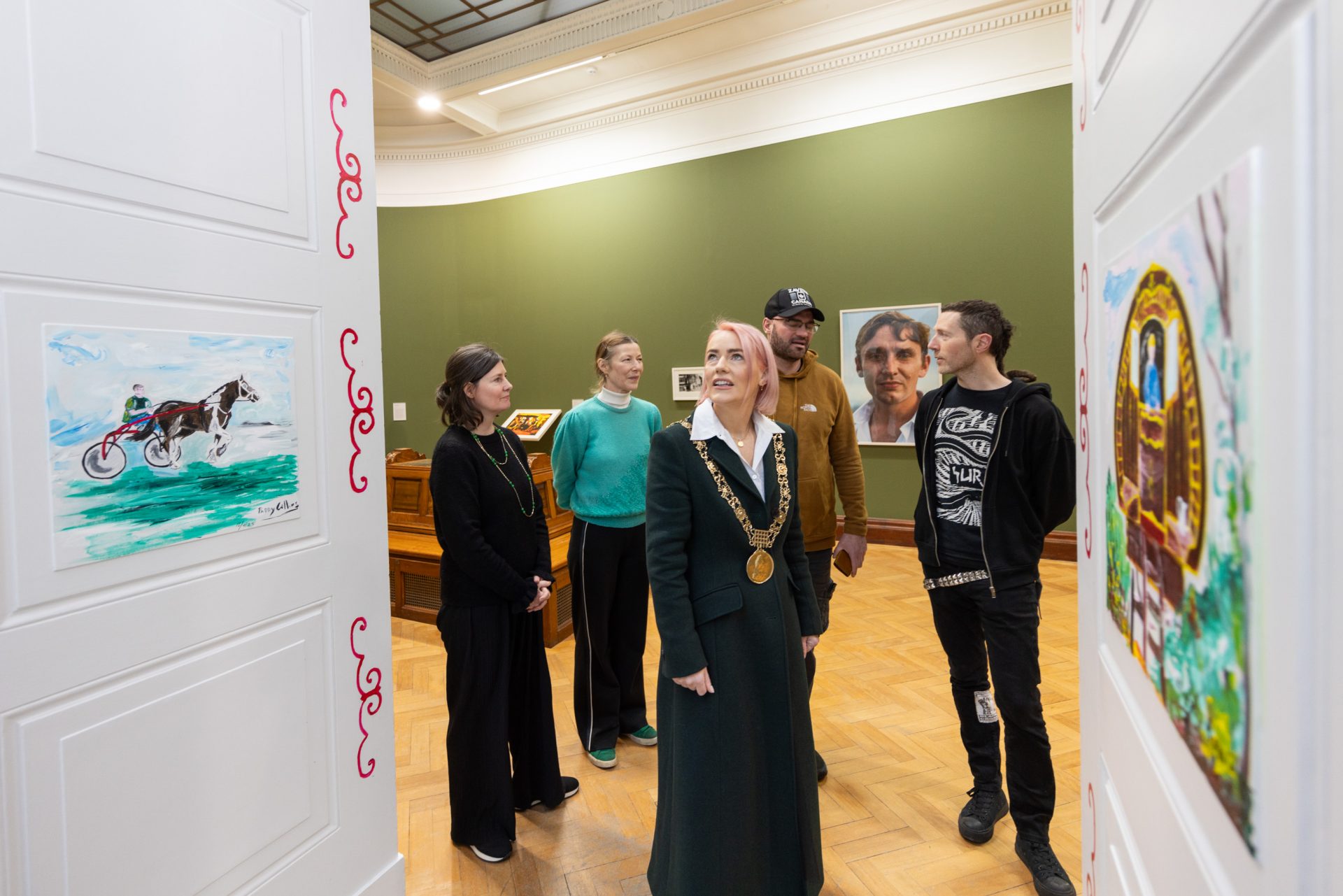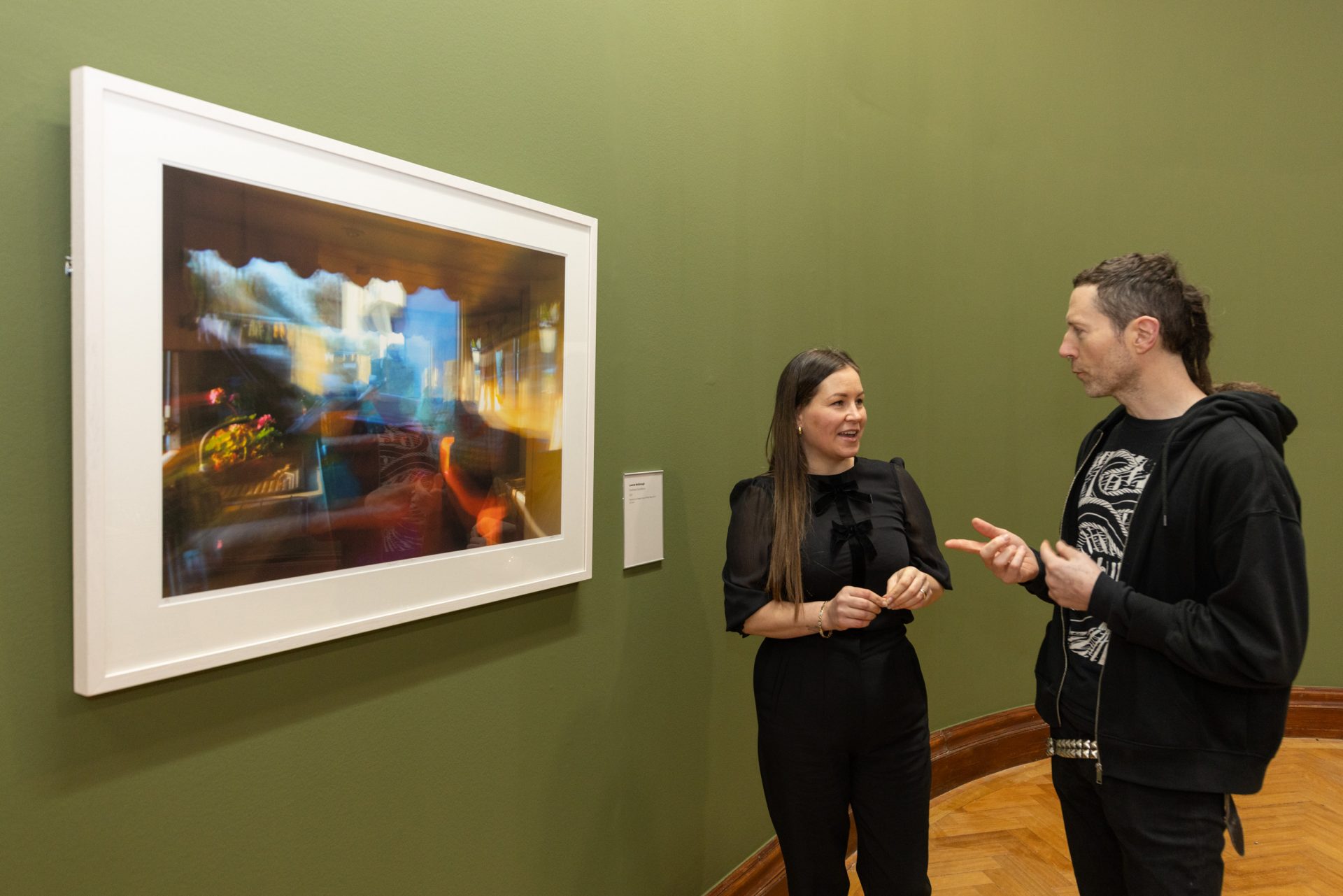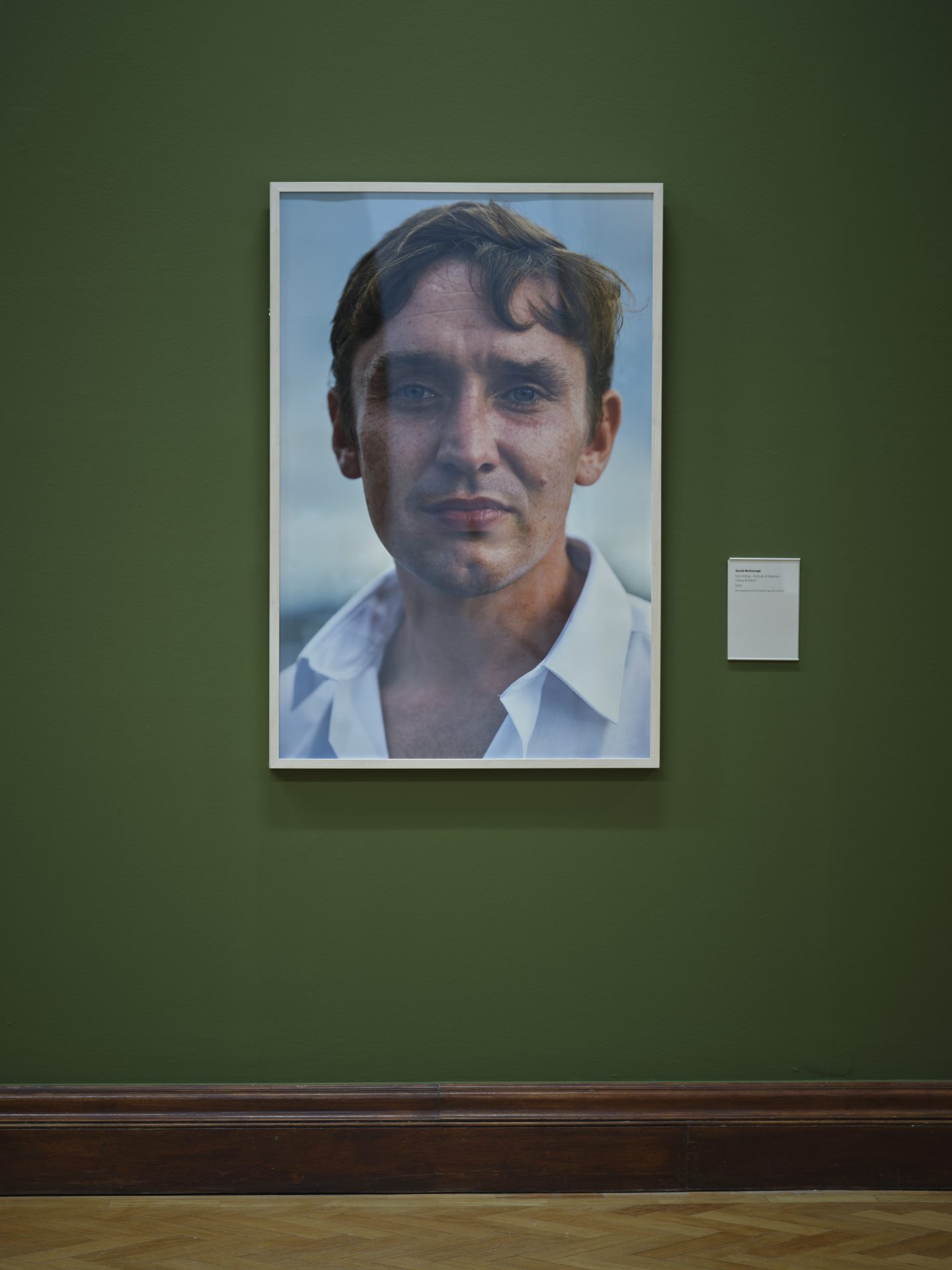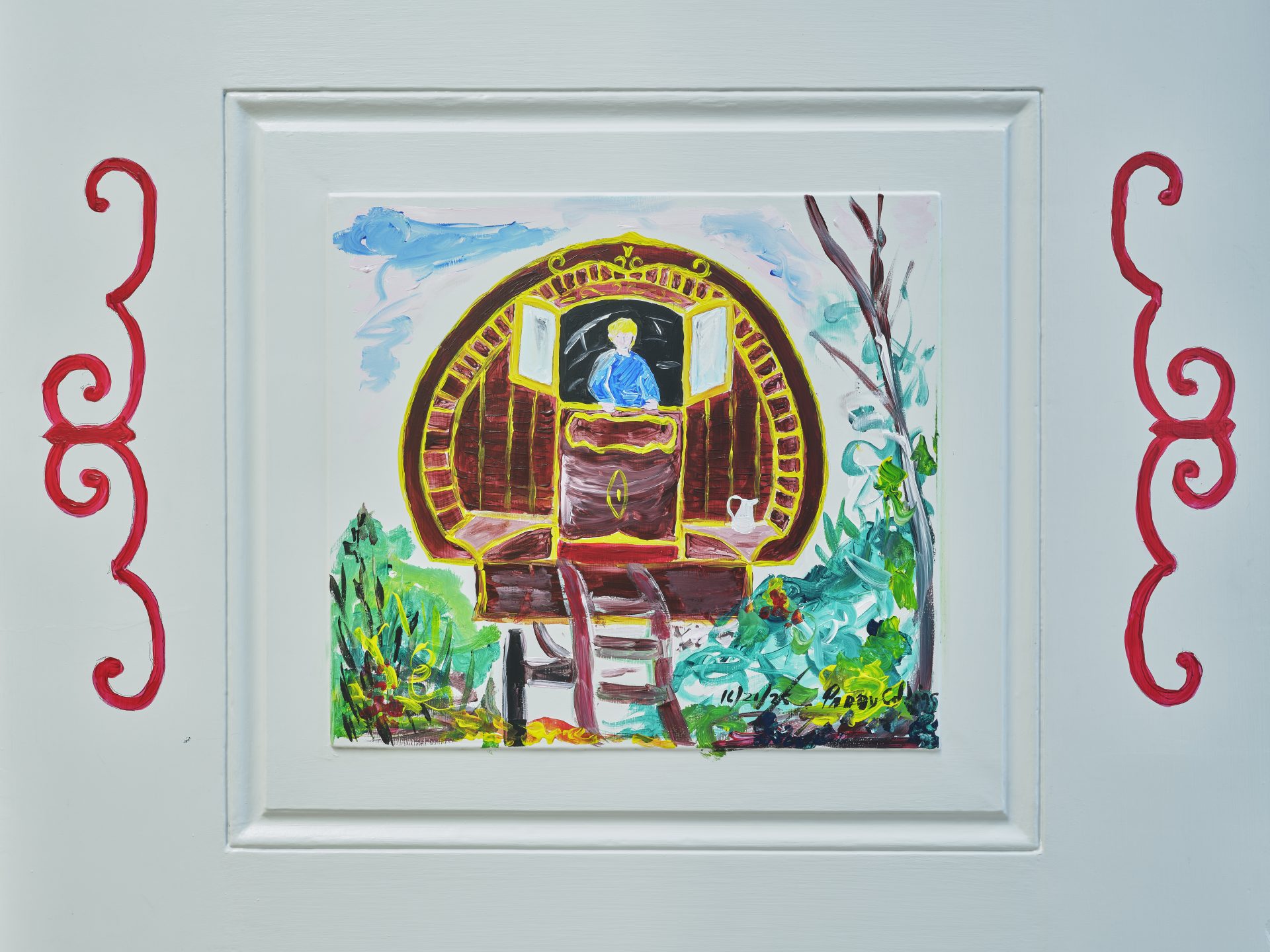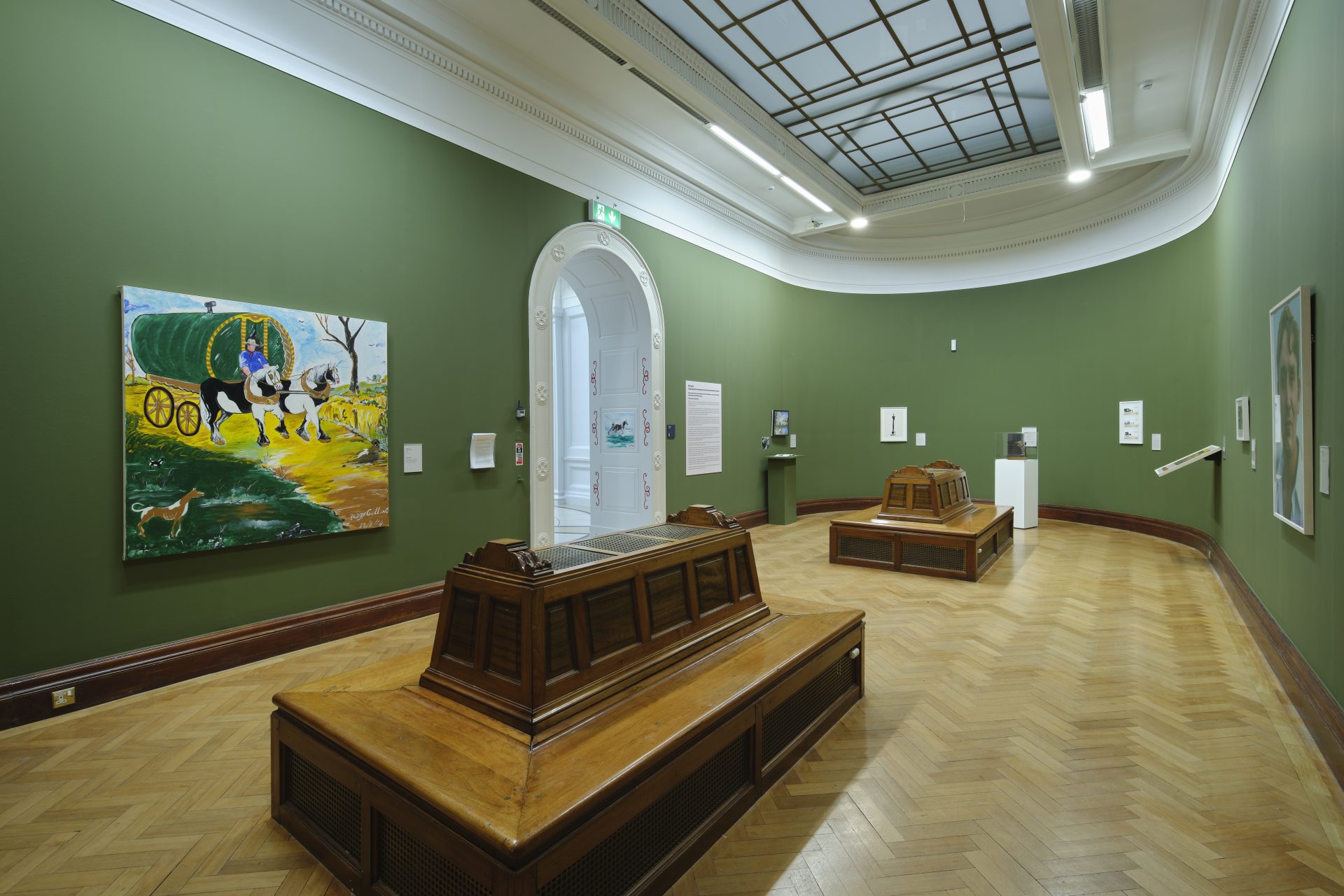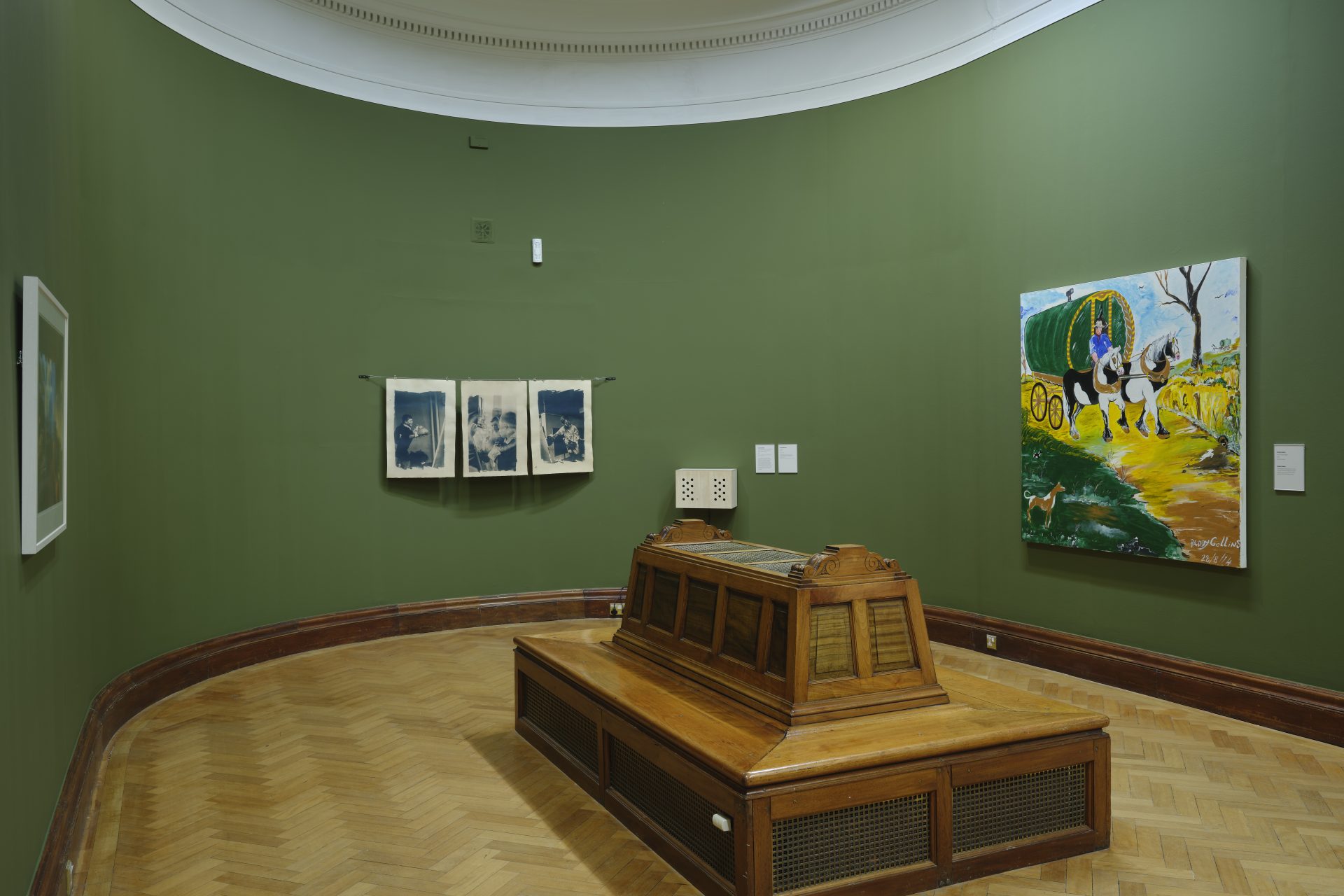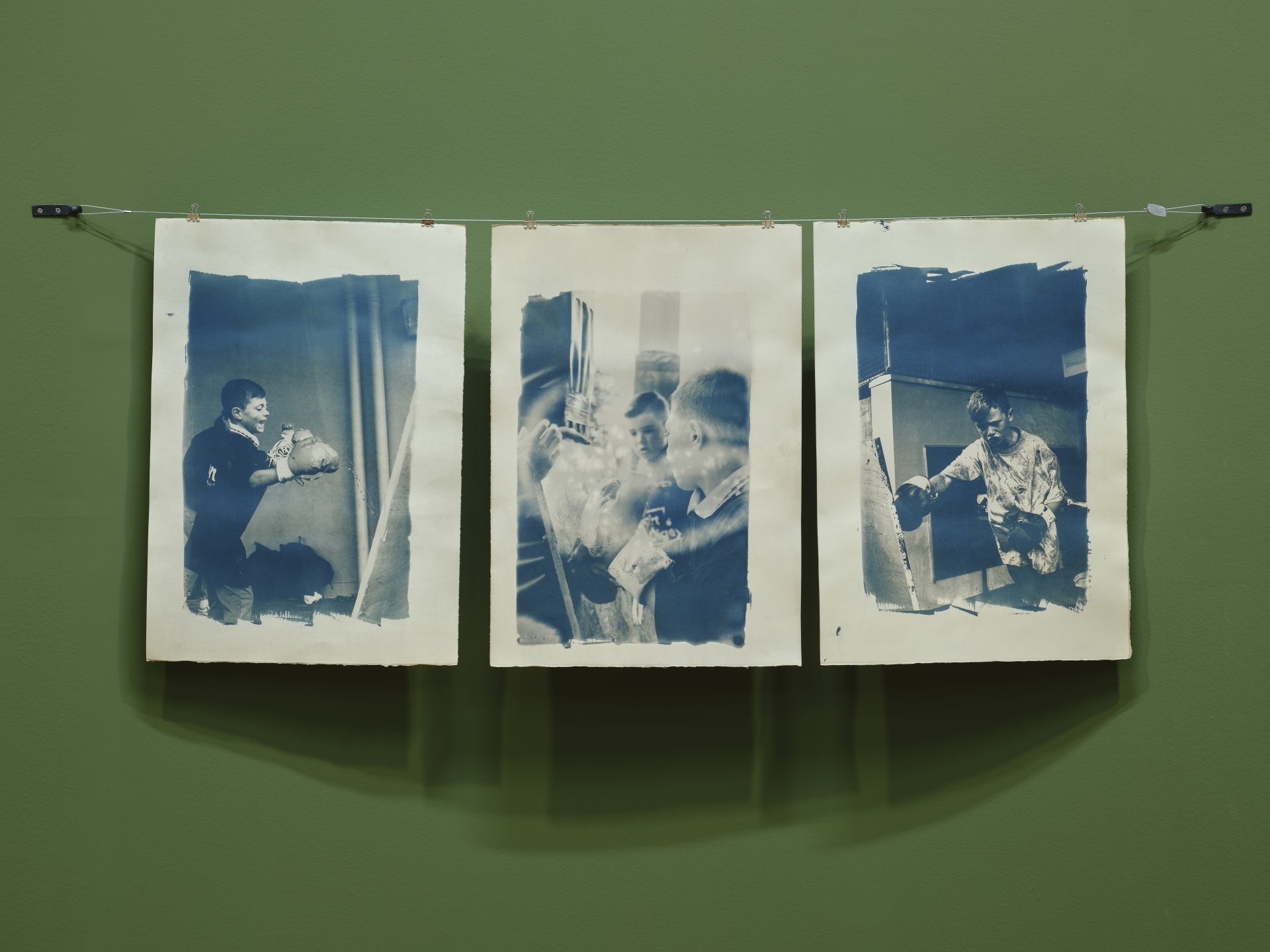Bafushia is an exhibition of contemporary artists who share Traveller heritage.
Bafushia at Hugh Lane Gallery is curated and organised as part of HLG’s Art Education programme in collaboration with artist Séamus Nolan and Pavee Point Traveller & Roma Centre.
Bafushia
(a physically bound process of forward movement)
Artists Chloe McDonagh, David McDonagh, Frank McCarthy, Leanne McDonagh, Paddy Collins and William Cauley
29 January-8 June 2025
Bafushia is an exhibition of contemporary artists who share a Traveller heritage. Hugh Lane Gallery is delighted to present this exhibition that gives insight into the lived experience of Irish Travellers through a Traveller lens.
Bafushia was launched by Lord Mayor of Dublin Emma Blain on Wednesday 29 January at 11am.
The word ‘Bafushia’ was discovered written in a sketchbook belonging to Jack B. Yeats alongside ‘Telling the Cards’ (1898; Collection: NGI). Through collective interpretation with participants from the Traveller community in a collaborative arts project led by artist Séamus Nolan and the Sligo Traveller Support Group in partnership with CAIRDE Sligo Arts Festival, the term was translated as a possible word for divining the future, ‘telling forward’, and for seeking out and imagining what lies ahead. While we have not been able to find any record of the word Bafushia being used by Traveller groups or anyone else, through the workshops with Traveller participants, an open and transparent process of inquiry led to the possibility that Bafushia might have been a localized term, reflecting how language evolves and gains meaning when spoken. The group’s collective speculative understanding of the word was one of being physically rooted while imagining the future—much like how the word Bafushia itself was a product of the group’s speculation.
As part of Bafushia at Hugh Lane Gallery, the Gallery’s collection was opened to a Traveller perspective where Travellers, through a process of visual inquiry, selected the artworks to include alongside the work of the contemporary artists on display. These workshops were facilitated by Arts educator and cultural worker Adam Stoneman with Michael Collins, Paddy Collins, Ann Maguire and Mags O’Sullivan.
Irish Travellers, a minority ethnic group, have a long-shared history of traditions, language, culture and customs that go back centuries. Traveller culture is based on a nomadic tradition and sets Travellers apart from ‘settled people’. While Travellers experience racism, discrimination, marginalisation and exclusion this exhibition demonstrates the resilience in the community, its strong creative tradition and an ability to look forward in strength and hope.
Bafushia at Hugh Lane Gallery is curated by Séamus Nolan in collaboration with Hugh Lane Gallery and Pavee Point Traveller and Roma Centre.
A publication with an essay ‘A Traveller Provocation’ by Dr Rosaleen McDonagh and a wide ranging programme of events will accompany this exhibition.
Our thanks to each of the exhibiting artists, to Séamus Nolan, Jessica O’Donnell, Head of Education and Community Outreach, Hugh Lane Gallery, and Caoimhe McCabe, Arts and Culture Coordinator Pavee Point Traveller and Roma Centre for organising this exhibition; and Adam Stoneman, Michael Collins, Paddy Collins, Ann Maguire and Mags O’Sullivan.
Bafushia is based on an exhibition which was devised as part of the Hereditas Project, a collaborative arts project led by artist Séamus Nolan in collaboration with Sligo Traveller Support Group in partnership with CAIRDE Sligo Arts Festival, funded by The Arts Council of Ireland’s Art: 2023 Centenary programme. Bafushia was presented by Cairde Sligo Arts Festival in collaboration with The Model as part of the festival programme in July 2024.
Bafushia on view here and accompanying publication and programme is supported by Hugh Lane Gallery and Pavee Point Traveller and Roma Centre.
-
‘A Traveller Provocation’ by Dr Rosaleen McDonagh
“Traveller Art, in all its forms, is an integral component of our struggle for political & cultural survival.” – RMD.
A Traveller Provocation
“Traveller Art, in all its forms, is an integral component of our struggle for political & cultural survival.” – RMD.
Context
While reflecting on Lady Gregory’s 1903 essay, “Our Irish Theatre: A Chapter of Autobiography,” her call rings sharp: “We must make our own propaganda.” Engaging critically with Gregory’s ideas, we uncover both parallels and tensions between her cultural revival and the Traveller Renaissance we see today. Gregory’s essay wrestles with colonialism and its lingering debris, articulating the urgency of dismantling derogatory Irish stereotypes—like the “pig in the parlour.” Her concern for the Irish psyche, its self-esteem and sense of self-worth, offers a stirring vision.
Her thesis was unflinching: art could confront colonialism and racism head-on. Her words speak to me now, as an Irish Traveller bearing witness to a Traveller Renaissance. Gregory envisioned a cultural awakening where Irish voices, through theatre, could reclaim their identity and demand space in the world of art. Her celebration of rural Irish life invited the nation to reclaim its stories, to write itself back into its cultural fabric. For Travellers, her essay resonates deeply. For our community, art isn’t just celebration—it’s resistance. It’s survival. It’s defiance against the tide of assimilation.
This response to Gregory’s vision reimagines it in the light of contemporary Traveller experiences. It questions the paradox of recognition without systemic support, the transformative power of community arts, and the pressing need for Traveller artists to control the narratives we create. Where Gregory sought to reclaim Irish culture from colonial erasure, Traveller art seeks to dismantle internal hierarchies and elevate diverse voices within Ireland’s broader cultural canon.
Our moment as Traveller creatives has arrived—a vibrant energy driving what I dare to call a Traveller art Renaissance. This Renaissance builds on a legacy of music, storytelling, embroidery, tin smithing, and other crafts rooted in everyday life. Our art has always been purposeful. Yet, when Traveller art is mentioned in historical contexts, it often centers on settled people’s representations of us—their misappropriations of our artefacts, histories, and identities. Institutional racism reinforced stereotypes through museums and cultural institutions, locking our stories out of reach. We had no access to theatres or galleries to see ourselves reflected. The ether carried those tropes, but access was a privilege Travellers rarely held.
Now, our art—in its vast forms, from music to performance to visual art—stakes its claim in the mainstream. Here lies the provocation: we are not here to amuse or educate or entertain. We are here to demand rights, recognition, and resources to live and to make great art. Economic reward, while important, is not the singular purpose. The disparities in recognition and opportunity remain stark. Celebration of Traveller art cannot come at the expense of confronting the deeper systemic issues our community faces. A grant or bursary alone cannot erase centuries of exclusion.
Traveller organisations must be resourced to employ community art workers—to nurture the collective voice. For over 40 years, our community has fought for fundamental human rights: housing, education, protection from racist evictions. Building cultural and artistic platforms isn’t a departure from this work but its natural progression—a way to preserve and share Traveller identity while challenging prejudice. Community art amplifies collective stories, not just individual visions. A Traveller-led initiative in this space fosters pride and resilience. Our shift from survival to celebration is a testament to the journey of our movement—a reclamation of identity.
The Paradox of Recognition
Today, Traveller artists are celebrated in exhibitions but often lack institutional backing or sustained support for professional development. This pattern reflects a troubling trend: arts funding for “diverse” cultures does little for the communities these cultures emerge from. Traveller art risks being consumed as an object—a static relic—rather than seen as a living, evolving act of cultural resistance. Local authorities may fund art projects while simultaneously denying our community culturally appropriate accommodations. The paradox is glaring.
Recognition, when hollow, risks devolving into tokenism. Including Traveller art in mainstream spaces, without addressing systemic inequality, reinforces power imbalances. Traveller artists are often relegated to “folk” or “ethnic” creators, their work celebrated for its quaintness but dismissed as peripheral to Irish art. For too long, settled artists caricatured our stories for settled audiences, stripping our dignity in the name of entertainment. We understand the nuances of the racist tropes embedded in those portrayals.
Similar as Black artists have fought systemic racism to have their voices heard. When the arts sector reflects only a narrow segment of society, it excludes both the artist and their audience. Traveller artists deserve inclusion across all art forms—theatre, dance, visual arts, and beyond. Representation will bring Traveller audiences, too, not confined to our own stories but embracing the spectrum of artistic engagement.
What’s missing in this framework is genuine recognition—not just of Traveller art’s value but of the lived experiences shaping it. Traveller art must sit at the heart of Irish culture, not as a footnote. To achieve this, our community must lead—funding, curating, interpreting, and owning our narratives. True recognition transforms institutions, forcing them to reflect our realities.
Art as Resistance
Traveller art, in all its forms, is resistance. It is survival in the face of systemic racism. Labeling it “craft” or “heritage” diminishes its power to challenge stereotypes. Instead, Traveller art inhabits Homi Bhabha’s “third space,” where identity resists simplistic categorization. To truly transform the Irish art world, we must dismantle the entrenched structures that limit our potential. This requires reimagining what it means to be Irish—and an Irish Traveller—in an equitable society.
Curatorial Control
Aruna D’Souza critiques the power structures of curatorial control, reminding us that inclusivity must go beyond token gestures. Traveller artists need ownership of our cultural artefacts—not just to be included but to curate and administer our work. Decolonizing the art world means dismantling the colonial frameworks that position our stories as marginal. Traveller artists must frame our experiences, using our authority to challenge the status quo. Without equitable funding and systemic reform, recognition will remain an empty gesture.
As Edward Said’s analysis of Orientalism shows, perpetuating colonial power dynamics through “high art” while marginalizing “folk art” is a dangerous trap. The question isn’t whether Traveller art can be included—it’s whether the structures sustaining the art world can reform to embrace the diversity of Irish society.
The Art of Defiance
For Traveller artists, inclusion is not enough. We demand ownership of the spaces that claim to welcome us. Claudia Rankine’s call for an art world that confronts its biases cannot remain an ideal; it is a necessity. Traveller art must reshape Irish culture, challenging dominant narratives while nurturing our community from within.
This provocation is not one-sided. Artists—Traveller or otherwise—must be free to create without the weight of representation. My own politics inform my work as a playwright, rooted in Traveller identity. Yet the provocation remains: will the institutions that invite us ever truly integrate our voices, or will they keep us at the margins? Kimberlé Crenshaw’s intersectionality reminds us that the compounded discrimination facing Traveller women must be addressed in both artistic and political realms. Traveller art is no monolith—it’s a multitude of voices demanding to be seen and heard.
This is our moment. We must be bold enough to showcase our work, to accept critique from peers and mainstream critics alike. Non-Travellers must engage with our art critically, without fear of perpetuating stereotypes. Through this engagement, art becomes transformative—personally, communally, politically. The test isn’t in being featured; it’s in redefining the spaces that feature us. Equity demands that our voices shape these spaces from within. As James Baldwin said, recognition is not just a gesture—it’s an act of defiance, compelling the world to see us as we are.
Dr Rosaleen McDonagh
-
Artists Biographies
Chloe McDonagh is a Graphic Designer and Multi Media Artist who is currently completing a BA(Hons) in Digital and Graphic Design at TUS Athlone. Winner of the Aontas STAR Award in 2023 Chloe has had her work exhibited in the National Museum of Ireland, and in the Axis centre in Ballymun as part of the Pisreóg project. Chloe was also a featured artist RTE Lyric FM’s Aedín in the afternoon, and in summer 2024 exhibited in ‘Bafushia’ in The Model Sligo, 2024.
‘My journey into the world of design is not just a professional pursuit but a personal pursuit of creativity. From the early days of childhood, to the intricate designs in this portfolio, my life through art has been a story of personal connection, persistent action, and infusing emotion into every piece.’ An Lucht Siúl was, ‘Created to celebrate the life of my late Father, Kieran McDonagh, telling the story of his and many other Irish Travellers upbringing. A golden road travelled by many, in deep silhouettes showing the progression from a nomadic lifestyle to being forced into social housing. An older man with his horse and wagon acknowledging the older generation and traditions. A young woman hanging out her washing beside her caravan as the living situation changes and finally, young children outside a house, stripped of the lifestyle and traditions but remaining in the silhouette giving in to the statement that all Travellers are painted with the same brush. However, no matter how we live and celebrate life the road is always golden wherever we go.’
David McDonagh is a self-thought photographer and filmmaker in love with the idea of telling stories. Recipient of the Misleór Short Documentary Grant in 2021 creating ‘Dreamer’ a short documentary about singer Kathleen Keenan, David was nominated in 2023 for the Bingham Ray Rising Star Award and won Best Short Documentary at the Galway Film Feadh for his film ‘Bring Put Back Together’. Exhibitions include ‘Bafushia’ in The Model, Sligo summer 2024, and in 2023 David had his first solo exhibition ‘Exposure’ in the Hyde Gallery Sligo as part of Cairde Sligo Arts Festival. David also showed work as part of the Pisreóg exhibition in the Axis Ballymun and completing a residency in Berlin.
Frank McCarthy is a printmaker, artist and recent graduate from Limerick Institute of Technology. He is a Musician Educator for Music Generation (Limerick, Cork City, Carlow and Kilkenny) and The Kabin Studio. He has also worked as a music and workshop facilitator and coordinator for The GAFF in Limerick City, a resource for community and voluntary arts in Limerick, facilitating direct connection between artists, communities and the wider public. Recent work by Frank includes ‘Paint Punch’, a unique project among young Traveller boys, where they combine their love of boxing with art, has been a huge success in Co Limerick, resulting in a major boost to their confidence and self-esteem, as well as improved attendance at school. Co-Producer of a short documentary film, Knuck & Knuckle with Monica Spencer in the GAFF Limerick. The film documents boxer Lee Reeves’ story in a gripping tale of how a young Limerick man uses his love of boxing to overcome the pain of losing his mother to suicide.
Leanne McDonagh is an award-winning Irish artist. She is also a teacher and a member of the Travelling community who grew up on a halting site, with first-hand experience of the prejudices and misconceptions that society has about Travellers.
As an artist she feels she has a unique opportunity to represent and record her community from within. She is currently working on a public sculpture funded by the Irish government – under the Percent for Art scheme. She has also illustrated a short story book, titled “Why the Moon Travels,” written by a fellow Traveller, Oein De Bhairduin, which is the first of its kind in Ireland and which is the recipient of many awards. Numerous pieces of her work were acquired by the Irish Museum of Modern Art in 2020, and they now form a part of the National collection of Ireland. Her work also features in both private and public collections, and since her debut in 2015 she has exhibited both nationally and internationally.
Additionally, Leanne also works as the Traveller education coordinator with Munster Technological University, and she is determined to use her life experiences, both positive and negative, for the benefit of present and prospective students from the Travelling community. Leanne established the Traveller Graduate Network in 2019 and is also developing a work experience programme aimed specifically at members of the Travelling community.
Paddy Collins is a self-taught painter who was born in the UK and moved back to Dublin when he was seven. His talent was spotted at school where he was encouraged to improve his arts skills. In the early 2000s, while working for Pavee Point Traveller & Roma Centre, Paddy had the opportunity of working with the painter Eamon Colman, who mentored him for a year, helping to refine and develop his craft. Paddy paints representations of traditional Traveller life, often depicting scenes of camps, fires, wagons, horses, dogs, and the natural world. He is deeply committed to promoting Traveller culture and traditions through his art and finds drawing and painting offer him a “peaceful place” of expression. His work is on display in a number of Traveller organisations and also in a number of private collections.
William Cauley 1954 – 2009, was a poet, author, and artist based in Limerick city. He was known locally as The Candlelight Painter because he painted at night-time by the flicker of candles in his caravan parked in the front garden of his house. William started travelling by himself when he was nine years old and many of the paintings he made from memory are based on the scenes that he encountered on his travels.
Séamus Nolan is an artist and doctoral student with the School of Art History and Cultural Policy UCD, the School of Visual Culture NCAD and the Collection Department in IMMA. He is conducting a practice-based study which examines the role of the contemporary museum in representing marginal cultures with a specific focus on Irish Travellers. Recipient of the 2024 O’Malley Art Award, recent artworks and curatorial projects include, Hereditas a collaborative artwork with CAIRDE Sligo Arts Festival and the Sligo Traveller Support Group which included both Bafushia and The Wandering Gaze/An Misló Swuner in the Model Sligo 2024 as well as Standing Ground in the Sligo City Hall 2023. Curator in residence for GUIDES an Arts Council collection exhibition in the Linenhall Arts Centre Mayo 2023, and Traveller Collection at the Hugh Lane Gallery a collaboration with Pavee Point Traveller and Roma centre 2018. This exhibition has emanated from research conducted with the financial support of Taighde Éireann – Research Ireland under Grant number EPSPG/2021/267.
-
Traveller Community Arts Day 1 May 2025
On Thursday 1 May 2025 the Traveller Community Arts Day, a celebration of Traveller culture at Hugh Lane Gallery took place.
Thursday 1 May 2025, 11am to 3pm
Schedule:
11am: Showcase of creative projects by Traveller organisations from Dublin, Galway and Offaly with presentations and chats.Followed by visit to La Grande Illusion exhibition with artist Brian Maguire.
Short Film Screenings:
2.00pm:’Being Put Back Together’ with input from film-maker Dave McDonagh.
2.30pm: ‘My Kind of People’ with film-maker Ella Louise Ward.In collaboration with Pavee Point Traveller and Roma Centre.
Brú Bhríde, Tuam
Bru Bhride Arts Hub has emerged as a vibrant centre for artistic expression, fostering a diverse range of projects spanning visual arts, drama, woodwork and music. Particularly noteworthy are the endeavours undertaken by youth members of St Christophers Youth Club , whose perspectives and voices have found resonance through various public exhibitions and performances.
In the realm of visual arts, Bru Bhride Arts Hub has been a canvas for innovative creations and explorations of identity. One standout exhibition, titled ‘About Me’, delved into the intricate art of portraiture, offering a glimpse into the lives and personalities of its subjects. Youth artists poured their experiences, dreams, and aspirations onto the portraits, creating a rich tapestry of narratives that transcended cultural boundaries.
This work was exhibited in Tuam Town hall and Galway City Library and documented in the National Traveller Archive in the National Museum of Ireland.
Bru Bhride Arts Hub stands as a testament to the transformative power of art in fostering dialogue, understanding, and social change. Through its diverse array of projects spanning visual arts, drama, music and woodwork, this creative enclave has provided a platform for youth members of the Traveller Community to share their stories, challenge stereotypes, and forge connections across divides.
Tullamore Traveller’s Women’s Shed – Offaly Traveller Movement
Threading Needles, Telling Stories, an exhibition of 14 three-dimensional hand-sewn dolls made by the women of the Chatters and Matters, Tullamore Traveller’s Women’s Shed. Threading Needles, Telling Stories is a storytelling through doll-making project led by artist and doll-maker Teresa Doyle. The purpose of this project is to explore Traveller heritage and culture in a new way, with each doll serving as a vessel for participants to demonstrate and tell the stories of their Traveller experiences.
Through this project, each participant had the opportunity to explore and share their heritage and culture in a new way, through the creation of a three-dimensional fabric doll-like figure. The dolls serve as a vessel to help demonstrate and tell the stories of the participant’s Traveller experiences, while reawakening skills that may be inherent for some group members. Skills including planning, designing, pattern-making, pattern-cutting, pressing, stitching, knitting and garment assembly were learned and practiced throughout the project, and the artists look forward to future learning and creative engagement.
Unpacking Traveller Mental Health – Traveller Primary Health Care Projects in the Eastern Region
‘Unpacking Traveller Mental Health’ is an immersive and multi-sensory approach to highlight the various dimensions that impact on Travellers’ mental health.
Drawing on the work from Syrian-born artist and architect Mohamad Hafez in his exhibition ‘Unpacked: Refugee Baggage’, this event uses traditional Traveller ‘grub-boxes’ to explore the individual, social and structural dimensions that impact on Travellers’ mental health.
U.S. based artist, Heather Harris, supported the development of each box by working with workers from Traveller Primary Health Care Projects in the Eastern Region. While people spoke about their work and their experiences recordings were made and the group worked together to transform ideas into a 3D format.
The exhibition consists of 10 grub boxes packed with expressions of the stresses impacting on Traveller mental health. The ten boxes reflect the experiences of different perspectives.
The Wheel of Time, Southside Traveller Action Group
This project was inspired by the International Contest for Minority Artists supported by the United Nations, which for 2025 has a focus on the theme of Belonging, Place and Loss.
Charlote Connors and Michael O Brien are youth workers with Southside Traveller Action Group and decided to develop work for the competition. They decided they wanted a wagonwheel with a road along the side showing all types of Traveller accommodation from the traditional barrel-top wagon to the updated chalets.
They began by looking for the wood they wanted for the project. “This really shows who we are as artists as we wouldn’t usually tend to go to a shop to find materials – we would rather seek them in our day to day lives,” explained Charlotte.
Some of the positive outcomes of the project came from spending time with the older members of their family, sharing discussion on ideas for the project and sharing stories about how when their grandparents were younger they would sleep under the barrel top wagons using hay and the heat of siblings to stay warm.
They also heard about the hardship the older Travellers lived through compared to Traveller lives today – this was emotional for the makers. “By the end we were left with a feeling of accomplishment and we are proud of our project that we took on,” said Michael.





